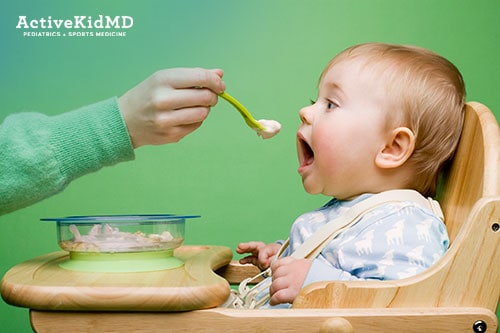I’d like to share common questions about timing and types of motor development in hopes that you will be better able to enjoy this special time.
When should I start “tummy time” with my baby?
Infants develop the ability to lift their head and neck in a push-up or upward dog position around 3 or 4 months of age. You can try to put your newborn face down on the floor before this age, but most will give you more crying than enjoyment.
Be aware that when you put your 3 and especially 4-month-old face down on the floor, not only will they lift their head, but they also will start to roll from stomach to back. Use extra caution with changing tables and bath time. It seems that these are the two times when most newborns like to show off their rolling skills!
Want to help that rolling and turning? Once a baby is 4 months of age, it is a sensible time to stop swaddling (especially the legs and hips) to encourage motor development.
When do I know when my infant is ready to start spoon-feeding? My baby is drooling a lot, does that mean that teeth are coming in?

Now, is spoon feeding essential for all infants at this age?
Read this blog post on Feeding Infants:Sensible Tips to Make Mealtimes more Enjoyable.
Now that I understand the spoon-feeding thing, when is a good time to start introducing more solids and table foods?
First of all, the main reason you’re introducing solid foods is to increase the pleasure in your child’s life. With few exceptions you are not introducing solids because breast milk or infant formula is lacking in some important nutrient. With that being said, babies develop the ability to pick up things with the thumb and first finger around 9 months of age.
Since they can usually sit up with good head and tongue control, this pincher grasp is the final piece that allows starting of solids and table foods.
When is a good time to check and double check child proofing where we live?
Ideally, parents can start child proofing even before a baby is born. However, the true test begins around 9 months of age with the development of that pincher grasp. Now any small object such as a small toy, piece of food, or even a coin can be considered a choking risk.
The ability to stand and pull on things makes electrical and drape cords a hazard along with bookshelves that can fall over on a now mobile infant.
My 7-month-old is not crawling, should I be concerned?

- lifting up head/neck
- rolling over
- sitting up
- pulling to stand
- standing
- walking.
These are motor skills that we routinely check on during well-child exams.
Notice that crawling is not on that list.
Not every baby crawls and in fact, so many babies do not crawl that we don’t even ask about it as a motor milestone.
If a baby does crawl, that is wonderful! However, a baby does not need to crawl as part of “normal” development.
My infant walks with their toes turned inward, is this a problem?
In-toeing or turning in of the toes is fairly common when kids begin to stand and walk. A common cause is tibial torsion, which is rotation of the shin bone that turns the feet towards each other. Parents should be able to rotate the feet and shin back and forth without any pain or limitation. Any pain or limitation (we call this rigidity) when moving feet or shins should be immediately evaluated by a physician.
Tibial torsion tends to go away by itself before the start of kindergarten, and there is usually no need for casting, braces or other concern. There are some kids who continue to have a slight turning in of the toes/feet even after kindergarten. As long as there is no limp, pain, or excessive clumsiness such as tripping over the feet, then there is little to do. In fact, there may even be some benefit as kids get older. There is some thought that kids who have their toes turn inward tend to be faster sprinters. That tends to turn a “problem” into a room full of smiles.
My child was quick to walk, throw, and kick balls, does this mean that she will be more advanced as she gets older?
Most kids take first independent steps and start walking around 12-15 months of age. The ability to kick balls and throw balls forward usually is developed around 18-24 months of age.
If a child is early to walk, kick or throw then that means that they were early to walk, kick or throw. Nothing more and nothing less.
There is no research or evidence that early walking, throwing or kicking makes for more advanced or skilled athletes as children grow older.
Of course, if you have specific questions or concerns about your child’s motor development, please contact a medical professional. At ActiveKidMD, we believe in the value of regular check-ups as your partner in the growth and development of your child.


